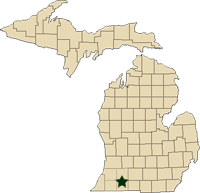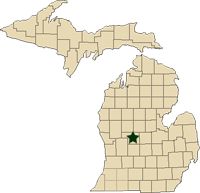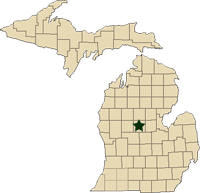Regional reports on Michigan field crops – June 28, 2012
MSU Extension educators’ pest and field crop updates for Michigan.
This week’s regional reports:
- Southwest Michigan - Bruce Mackeller
- West Central Michigan – Fred Springborn
- Central Michigan – Paul Gross
Southwest Michigan – Bruce Mackellar, Michigan State University Extension
|
Weather
Hot, dry and relatively windy conditions following cool and dry weather have left crops parched and growers wondering if it will ever rain again in southwest Michigan this summer. The relatively good news is that there is a slight chance for an isolated thunderstorm developing this afternoon (June 28) with the passage of a cold front. The chance is slight, but better than no chance at all. Brown is the new green in lawns, soybean and corn fields across the southwest region.
Rainfall
Sparse rainfall fell with widely scattered thunder showers last Friday (June 22). On average, rainfall totals are running around 1.5 to 2 inches behind for the last two weeks, about 1.5 to 2.5 inches behind for the last four weeks and 3 to 4 inches behind since April 1. Below normal precipitation is indicated in the 6-to-10-day outlook from NOAA, with normal precipitation predicted to areas from Grand Haven, Mich., northward. The dry area is expected to move northward in the 8-to-14-day outlook.
Temperature
A heat bubble ridge from Chicago to Colorado and running through the plains will keep our temperatures above normal in the 6-to-10-day period. The 8-to-14-day outlook shows the heat intensifying and moving east into Michigan. Growing degree day (GDD) totals are 915 base 50 GDDs since May 1. We normally accumulate around 21.2 GDDs base 50 during the next five-day period.
Crops
Early planted commercial corn is at V12 to V10. Most later planted corn is V8 to V9. Moisture stress has become drought stress in southwest Michigan. Many corn fields have just about run through the available soil moisture and are having difficulty to recover from stress during the overnight period. We are beginning to lose lower leaves to the stress. The situation will become critical in many fields here over the weekend without rainfall.
Early planted soybeans are R1 (flowering). Most dry land soybeans appear to have pretty much stopped growing with the hot and dry conditions. The good news is that soybeans have a much better propensity to respond to improved growing conditions later in the season than corn. There are low numbers of soybean aphids in some areas, but so far they are have not been much of a problem. We will need to continue to monitor for aphids and spider mite activity.
Wheat harvest is underway.
Most growers have harvested second cutting alfalfa. Yields on second cutting hay have been good. Potato leafhopper numbers have remained low to moderate. Keep an eye on alfalfa re-growth. Threshold is one potato leafhopper adult per sweep in the early re-growth stage.
Crop insurance
Be sure to document stress and contact your crop insurance agent if drought conditions impact your crops. Keeping agents informed during the process can help to establish claims later in the season.
West Central Michigan – Fred Springborn, Michigan State University Extension
|
Weather
No significant rain in the past week. I have had reports of around 1/10 inches in the northern areas of the region late last week. High air temperatures ranged from the upper 70s to the mid-80s. Low air temperatures were in the upper 40s to low 60s. While we have had a few days that felt humid, average humidity levels are still quite low for the season from the low 60s to low 70s. Soil conditions are getting quite dry on the south end of the region, and rain would certainly be welcomed, but we are not yet experiencing the scale of injury reported in the southwest region, as well as states to the south and west of Michigan.
Crops
Wheat is drying down. No significant harvest to report yet.
Oats are turning.
Corn ranges from V5 to V12 with much of the crop between near V10. Corn on light-textured soils without irrigation is starting to roll its leaves during the heat of the day. Monitor soil moisture carefully in irrigated fields over the next few weeks.
Many alfalfa producers on irrigated and heaver-textured soils are harvesting or finishing up second cutting. Potato leafhopper numbers continue to be fairly low, but will need to be monitored.
Dry bean planting is complete in Montcalm and Mecosta counties. Several fields have their first trifoliate leaves. There are a few recently planted fields lacking sufficient moisture to germinate.
Soybeans are variable in growth stage with very low numbers of aphids present. Japanese beetles are present in a number of fields.
We continue to catch low numbers of western bean cutworm adults in pheromone traps – one to 10 per trap per week.
Central Michigan – Paul Gross, Michigan State University Extension
|
Weather
Another week without rain is beginning to show as crops are indicating moisture stress. The short-term weather forecast is not encouraging. Most areas of the region have been fortunate to get timely rains thus far this spring, but any surplus subsoil moisture is running out. The evapotranspiration rates with the high temperatures are reaching 2/10 to 3/10 of an inch per day. Areas of fields where there are problems such as compaction are very evident. With the dry weather upon us, the fields with higher organic matter are handling the stress much better because of the increased water-holding capacity of these soils. Each percent organic matter can hold about an acre inch of water. Management strategies to increase organic matter can help drought proof your soils.
Commodity reports
The corn crop ranges from V5 to V12. We seem to be past most insect pest problems at this point in the season. The crop is starting to show moisture stress. No western bean cutworm moths have been caught in traps. Scout fields for evidence of corn rootworm feeding.
Soybeans range from the one to three trifoliate leaf stage. Stands vary widely due to emergence and insect problems. Weed size is becoming an issue in fields that have not had herbicide applied. Be carefult to not let weeds get too big. With the hot weather and drought conditions, managing these big weeds can be difficult. Special attention should be paid to conventional beans. Scout fields for spider mites and soybean aphids. These pests are more likely in dry conditions.
The wheat crop is ripening very quickly. We expect harvest to begin early next week. There is very little agreement on what wheat yields might be at this time. With the early harvest, consider planting a cover crop on these acres to protect these fields from weeds and build organic matter.
Harvest of second cutting alfalfa is well underway. Most are reporting very good yields and quality. Scout these fields for potato leafhoppers.
Oats are beginning to turn with yield prospects good. Yields will depend on rain between now and harvest.
Dry bean planting has wrapped up. Stands are generally good. There were some stand problems early on that lead to some replants. Scout for potato leafhoppers. Get the western bean cutworm traps up on these fields to help manage this pest.
Sugarbeets are filling the rows and continue to progress, but are in need of moisture.
Additional information
- MSU Extension’s Drought Resources



 Print
Print Email
Email





